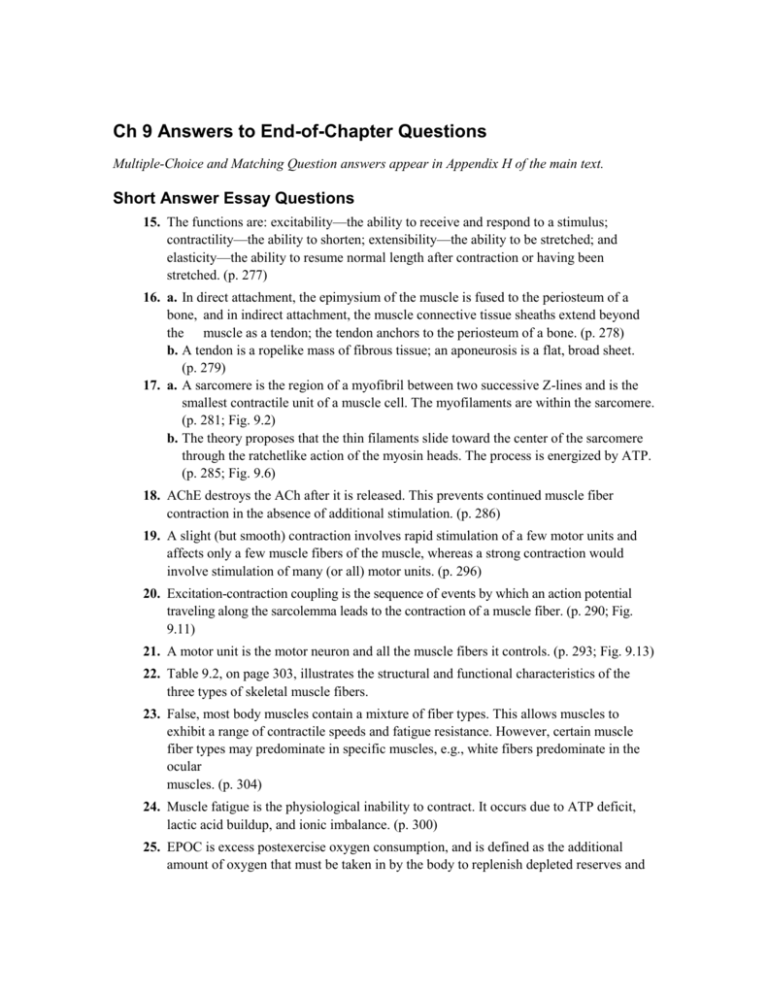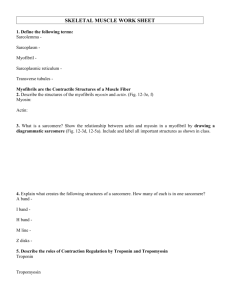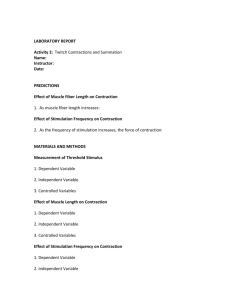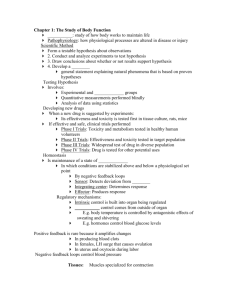Ch 9 Answers to End-of
advertisement

Ch 9 Answers to End-of-Chapter Questions Multiple-Choice and Matching Question answers appear in Appendix H of the main text. Short Answer Essay Questions 15. The functions are: excitability—the ability to receive and respond to a stimulus; contractility—the ability to shorten; extensibility—the ability to be stretched; and elasticity—the ability to resume normal length after contraction or having been stretched. (p. 277) 16. a. In direct attachment, the epimysium of the muscle is fused to the periosteum of a bone, and in indirect attachment, the muscle connective tissue sheaths extend beyond the muscle as a tendon; the tendon anchors to the periosteum of a bone. (p. 278) b. A tendon is a ropelike mass of fibrous tissue; an aponeurosis is a flat, broad sheet. (p. 279) 17. a. A sarcomere is the region of a myofibril between two successive Z-lines and is the smallest contractile unit of a muscle cell. The myofilaments are within the sarcomere. (p. 281; Fig. 9.2) b. The theory proposes that the thin filaments slide toward the center of the sarcomere through the ratchetlike action of the myosin heads. The process is energized by ATP. (p. 285; Fig. 9.6) 18. AChE destroys the ACh after it is released. This prevents continued muscle fiber contraction in the absence of additional stimulation. (p. 286) 19. A slight (but smooth) contraction involves rapid stimulation of a few motor units and affects only a few muscle fibers of the muscle, whereas a strong contraction would involve stimulation of many (or all) motor units. (p. 296) 20. Excitation-contraction coupling is the sequence of events by which an action potential traveling along the sarcolemma leads to the contraction of a muscle fiber. (p. 290; Fig. 9.11) 21. A motor unit is the motor neuron and all the muscle fibers it controls. (p. 293; Fig. 9.13) 22. Table 9.2, on page 303, illustrates the structural and functional characteristics of the three types of skeletal muscle fibers. 23. False, most body muscles contain a mixture of fiber types. This allows muscles to exhibit a range of contractile speeds and fatigue resistance. However, certain muscle fiber types may predominate in specific muscles, e.g., white fibers predominate in the ocular muscles. (p. 304) 24. Muscle fatigue is the physiological inability to contract. It occurs due to ATP deficit, lactic acid buildup, and ionic imbalance. (p. 300) 25. EPOC is excess postexercise oxygen consumption, and is defined as the additional amount of oxygen that must be taken in by the body to replenish depleted reserves and reconvert lactic acid to pyruvate. This quantity of oxygen is in addition to the oxygen currently required for aerobic metabolism. (p. 301) 26. Smooth muscle is located within the walls of hollow organs, including blood vessels. It is highly fatigue resistant, and tolerates stretch. These characteristics are essential because the vessels and hollow organs must respond slowly, fill and expand slowly, and avoid expulsive contractions. (pp. 305–307) Critical Thinking and Clinical Application Questions 1. Regular resistance exercise leads to increased muscle strength by causing muscle cells to hypertrophy, or increase in size. The number of myofilaments increases in these muscles. (p. 305) 2. The reason for the tightness is rigor mortis. The myosin cross bridges are “locked on” to the actin because of the lack of ATP necessary for release. Peak rigidity occurs at 12 hours and then gradually dissipates over the next 48 to 60 hours as biological molecules begin to degrade. Had the coroner found the body three days later, the muscles would have been relaxed. (p. 293) 3. Chemical A would be a better muscle relaxant. By blocking binding of ACh to the motor end plate, neural stimulation of the cell is blocked, and the muscle cell cannot depolarize. Chemical B would actually increase contraction of the muscle cell by increasing the availability of calcium ions that bind to troponin, contributing to actinmyosin cross bridging. (pp. 286–289) 4. The calcium actually binds to troponin, which changes shape and moves the tropomyosin to expose the myosin head binding sites. (p. 289)










